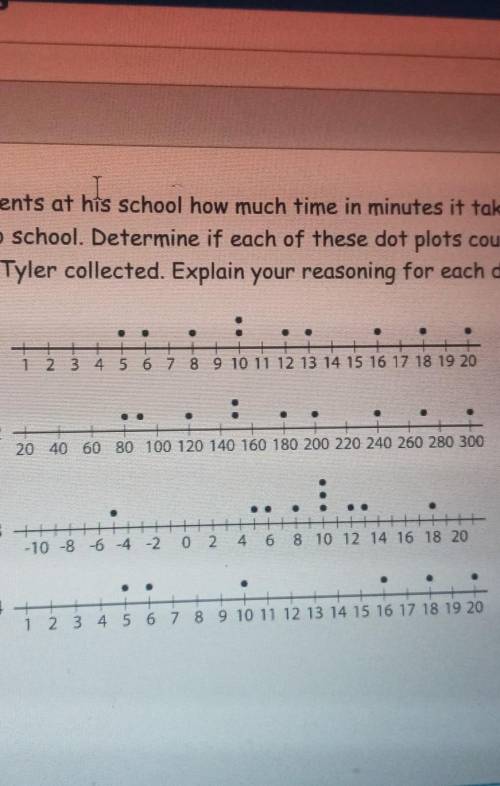
Mathematics, 12.05.2021 19:00 122333444469
Tyler asked 10 students at his school how much time in minutes it takes them to get from home to school. Determine if each of these dot plots could represent the data Tyler collected. Explain your reasoning for each dot plot. dot plot: please help on my last quarter and i need to get my math grade up!!!


Answers: 1


Other questions on the subject: Mathematics

Mathematics, 21.06.2019 14:30, TheCampingStone
The sum of two numbers is 58. the first number is 8 less than half the second number. let c represent the first number. let drepresent the second number. which statements about solving for the two numbers are true? check all that apply. the equation  represents the sum of the two numbers. the equation  represents the sentence “the first number is 8 less than half the second number.”the equation  represents the relationship between the two numbers. the equation  represents the sum of the two numbers. the number d is 14.the number c is 44.the number c is 14.the number d is 44.
Answers: 1

Mathematics, 21.06.2019 16:30, sjaybanks4067
Asequence {an} is defined recursively, with a1 = 1, a2 = 2 and, for n > 2, an = an-1 an-2 . find the term a241
Answers: 2

Mathematics, 21.06.2019 19:30, cykopath
Me max recorded the heights of 500 male humans. he found that the heights were normally distributed around a mean of 177 centimeters. which statements about max’s data must be true? a) the median of max’s data is 250 b) more than half of the data points max recorded were 177 centimeters. c) a data point chosen at random is as likely to be above the mean as it is to be below the mean. d) every height within three standard deviations of the mean is equally likely to be chosen if a data point is selected at random.
Answers: 2

Mathematics, 21.06.2019 21:30, gonzalezashley152
In a test for esp (extrasensory perception), the experimenter looks at cards that are hidden from the subject. each card contains either a star, a circle, a wave, a cross or a square.(five shapes) as the experimenter looks at each of 20 cards in turn, the subject names the shape on the card. when the esp study described above discovers a subject whose performance appears to be better than guessing, the study continues at greater length. the experimenter looks at many cards bearing one of five shapes (star, square, circle, wave, and cross) in an order determined by random numbers. the subject cannot see the experimenter as he looks at each card in turn, in order to avoid any possible nonverbal clues. the answers of a subject who does not have esp should be independent observations, each with probability 1/5 of success. we record 1000 attempts. which of the following assumptions must be met in order to solve this problem? it's reasonable to assume normality 0.8(1000), 0.2(1000)%30 approximately normal 0.8(1000), 0.2(1000)% 10 approximately normal srs it is reasonable to assume the total number of cards is over 10,000 it is reasonable to assume the total number of cards is over 1000
Answers: 1
You know the right answer?
Tyler asked 10 students at his school how much time in minutes it takes them to get from home to sch...
Questions in other subjects:

Social Studies, 26.07.2019 22:00




History, 26.07.2019 22:00




Physics, 26.07.2019 22:00

Mathematics, 26.07.2019 22:00



